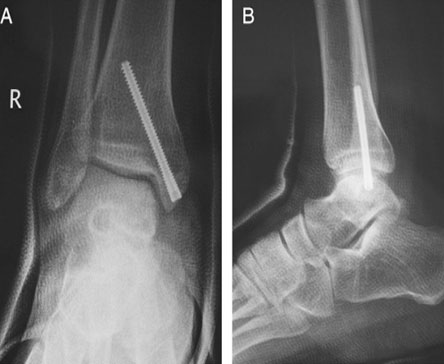Tuluhan Yunus Emre MD, Tolga Ege MD, Hakan Turan Çift MD, Demet Tekdöş Demircioğlu MD, Bahadır Seyhan MD, Macit Uzun MD,
Department of Orthopaedic Surgery, Istanbul Memorial Hizmet Hospital, Istanbul, Turkey
Department of Orthopaedic Surgery, Gulhane Military Hospital, Ankara, Turkey
Department of Orthopaedic Surgery, Etimesgut Military Hospital, Ankara, Turkey
Memorial Hizmet Hospital, Istanbul, Turkey
Abstract
Osteochondral lesions of the talus present with symptoms of pain and painful motion, affecting the quality of the patient’s daily life. We evaluated the 2-year short-term outcomes of patients whose large osteochondral lesions of the talus were treated with medial malleolar osteotomy and a mosaic graft harvested from the knee on the same side. A total of 32 patients who had cartilage lesions due to osteochondritis dissecans in the medial aspect of the talus underwent mosaicplasty after medial malleolar osteotomy. The patients were followed up for a mean period of 16.8 (range 12 to 24) months. The staging and treatment plan of the osteochondral lesions of the talus were made according to the Bristol classification. The follow-up protocol for the patients included direct radiography and magnetic resonance imaging. The American Orthopaedic Foot and Ankle Society scoring system was used to assess the patients during the pre- and postoperative periods. Of the 32 patients, 3 (9.4%) were female and 29 (90.6%) male, with a mean age of 27.5 (range 20 to 47) years. The mean preoperative American Orthopaedic Foot and Ankle Society score was 59.12 ± 7.72 but had increased to 87.94 ± 3.55 during the postoperative 2 years. The increase in American Orthopaedic Foot and Ankle Society score was statistically significant (p < .05). We have concluded that open mosaicplasty is a reliable and effective method for the treatment of osteochondral lesions with subchondral cyst formation in the talus, exceeding 1.5 cm in diameter.
2012 by the American College of Foot and Ankle Surgeons. All rights reserved.
Ostechondral lesions of the talus present with symptoms of pain, diffuse swelling, tenderness, and sometimes locking of the joint, with restricted motion in the chronic stage of the disease affecting patients’ daily life. Typically, patients can experience this complaints for months or even years before the diagnosis is made from the clinical and radiologic examination findings. Although trauma remains the major etiologic factor; osteonecrosis, endocrine disorders, and genetic factors have also been responsible for these lesions. An ankle sprain is 1 of the most common injuries in sports. Approximately 5% of these sprains will result in osteochondral lesions to the talus. Osteochondral lesions can result from direct trauma or from recurrent microtrauma (2,5). According to a study by Berndt and Harty, 43.7% of transchondral fractures of the talar dome were located in the lateral border, with most located in the middle third of the border, and 56.3% at the medial of the talus, usually in the posterior third of the border. Local chondral or osteochondral lesions involving the articular surface of the talus usually present with pain, swelling, locking, and instability. The clinical history is very important in the detection of osteochondral lesions of the talus. The diagnosis is made from the history, physical examination, plain radiography, scintigraphy, and, in particular, magnetic resonance imaging (MRI) and diagnostic ankle arthroscopy findings. A 4-stage classification described by Berndt and Harty (2) had been widely used in staging and determining the treatment plan for osteochondral lesions of the talus. However, with the widespread use of MRI, new classifications, such as the Bristol classification, have been used in several studies. The Bristol classification is a representative MRI-based classification. The treatment strategies and techniques for osteochondral defects of the ankle have increased drastically in the past decade. The common treatment options for symptomatic osteochondral lesions include nonoperative treatment with rest or cast immobilization and surgical treatment. The most commonly used surgical options are excision of the lesion, excision and curettage, excision combined with curettage and drilling/microfracturing, placement of an autogenous (cancellous) bone graft, antegrade drilling, retrograde drilling fixation, and, finally, newer techniques such as osteochondral

